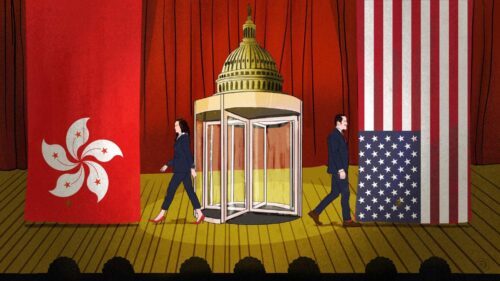No ‘Beijing Consensus’: Why the U.S. risks a Pyrrhic victory in confronting China
How will the coronavirus reshape China’s domestic and international standing? What lies ahead for U.S.-China relations and the international order?

The Chinese Communist Party (CCP) leadership is first and foremost concerned with its domestic survival. Since the late 1970s, the CCP leadership has relied on growth, nationalism, and stability to justify authoritarian rule, but these pillars are often in tension with one another. Rather than a monolith, “China” encompasses 1.3 billion people, 31 provinces, and a regime that must grapple with enormous internal diversity, using coercion, persuasion, and cooptation to remain in power.
The coronavirus outbreak in Wuhan came as a shock to this tenuous equilibrium — jeopardizing popular and elite support for the way the CCP has governed under Xí Jìnpíng 习近平. The government’s initial delays in confirming evidence of human-to-human transmission, and the silencing of local doctors who tried to inform their colleagues about a new SARS-like virus, elicited sharp critiques of Chinese-style authoritarianism and calls on Chinese social media for Xi to step down (links in Chinese).
But the CCP’s subsequent success in containing the virus, especially as other countries have struggled, has emboldened Chinese nationalists and propagandists to claim the superiority of Chinese efforts — and their system — to combat the epidemic. Meanwhile, the CCP has silenced outspoken critics like retired real estate tycoon Rén Zhìqiáng 任志强 and legal activist Xǔ Zhìyǒng 许志永.
This nationalistic turn has elevated global skepticism. While some have praised China’s progress in disease control, others continue to criticize its initial missteps, including potential cover-ups. Today, Beijing faces mounting calls from around the world for an independent investigation into the origins of the coronavirus outbreak and even reparations for its early mishandling. Its combative response has only exacerbated that mistrust.
Anti-foreign discrimination at home has further impaired China’s image abroad, including the evictions and harassment of African migrants in Guangzhou. China’s aggressive and nationalistic responses to the growing demands of accountability abroad and signs of xenophobia at home have undermined its efforts to craft a benevolent image, in spite of its “mask diplomacy” and other concerted efforts. Although Beijing has somewhat softened its nationalist rhetoric following domestic and international backlash, denying any intent to export its coronavirus response model, even China’s internal reporting finds that global antipathy toward China is at its highest level since 1989.
What China’s response to the pandemic reveals about its intentions
The CCP’s coronavirus response has pushed the CCP away from reliance on rapid growth, which turned negative for the first time in decades in the first quarter. It has also clarified the order of priority between nationalism and public safety. The CCP put safety and stability first, even cracking down on conspiracy rumors in the initial response. Nationalist propaganda and “wolf warrior diplomacy” came only after the health situation was taken care of, and potential instability quieted.
What has ensued is a very aggressive effort to beat back international criticism of the CCP. Does this represent a fundamental shift in Beijing’s strategy — or continuity? As I wrote in Foreign Affairs last summer, the CCP seeks a world safe for autocracy — first and foremost defending itself against the threat of democratic diffusion and foreign efforts to subvert the CCP through “peaceful evolution.” But this effort to defend the CCP’s rule at home has also become increasingly international in scope — both for retaining support for the CCP and defusing diasporic challenges, which have traditionally been a threat to regime security. China’s diplomacy and contributions to global governance have also sought to project an image of global leadership, which surveys show the domestic Chinese public increasingly values.
Far from an imagined “Beijing consensus,” there is a spectrum of domestic opinion — with some advocating a much more aggressive effort to proclaim and promote a China model. Others on the liberal end of the spectrum argue that China’s success owes more to the unleashing of markets and private enterprise than state-directed efforts.
Under Xi, Chinese leaders have increasingly promoted a China “solution,” including “blazing a new trail for other developing countries to achieve modernization.” Yet Xi and other Chinese spokespeople have explicitly denied any intent to export this model or require others to copy China. So far, this rhetoric appears to be more about advertising an option than requiring conformity to a particular form of governance as a condition of Chinese assistance.
As hopes for regime change and criticism of the CCP have grown abroad, so has the CCP’s willingness to show off its resolve and proclaim a superior system. In a September 2019 speech, Xi called on Chinese cadres to “dare to struggle, and be good at fighting” (敢于斗争、善于斗争 gǎnyú dòuzhēng, shànyú dòuzhēng) when faced with risks and challenges that threaten the CCP’s leadership and the great rejuvenation of the Chinese nation.
This new, abrasive “wolf warrior diplomacy” has gained steam with the pandemic. Chinese propaganda efforts have extended beyond defending the CCP’s performance and showcasing the failings of liberal democratic states like the United States. They have gone further to amplify conspiracy theories blaming the U.S. for the coronavirus and false information about U.S. lockdowns. Even Huawei was recently criticized for attempting to sponsor a panel discussion on how misinformation is hurting minority communities in the U.S. These are nascent signs of China-backed initiatives to sow division; and while they are nowhere near the scale and audacity of Russian efforts, they suggest a shift in tactics — from promoting China’s interests and image to influencing the public discussion in the U.S. on other issues.
While it’s fair to ask whether this reflects a larger change in Chinese strategy, the CCP’s coronavirus response continues to look more heavily weighted toward nationalist realpolitik than a universalizing ideology. To the extent that China’s “mask diplomacy” has come with political strings, they have been to seek praise for China’s assistance and dampen criticism of its initial missteps, not to oblige others to follow Chinese-style authoritarianism. So far, there is no indication of a systematic framework for China’s COVID-19 assistance. In fact, a senior foreign policy adviser recently called for the government to make a coherent plan to distribute COVID-19 aid to dispel the appearance that China was seeking political gains.
Ultimately, to assess “what China wants” — which is contested and constantly being updated as domestic and international pressures arise — we need to more rigorously study Chinese rhetoric as well as behavior. Some analysts have written that careful analysis of important speeches and statements by top leaders “should have decisively ended our debate about the nature and scope of Beijing’s strategic intentions,” particularly Xi Jinping’s speech to the 19th Party Congress about “Chinese socialism’s entrance into a new era.”
But while key documents and slogans set a direction, they are also vague by design. Inevitably their content will be contested, both in design and implementation. My research on Chinese rhetoric suggests that tough but ultimately vague talk, or bluster, has provided cover with domestic audiences for pragmatic restraint — shoring up public approval even when the government does not follow through with real action.
Opinion polls show that the Chinese public is hawkish on territorial disputes and American military operations in Asia. Younger Chinese, while perhaps not more nationalist in identity, may be more hawkish in their foreign policy beliefs than older generations. Internet users and elites are even more inclined to call on the Chinese government to invest and rely more on military strength. But research also shows that the Chinese public has a considerable appetite for international leadership — as well as pacifism.
The CCP has been able to placate these different audiences through mixed messages, bluster, and sweeping rhetoric about leading a shared future for humankind. Underneath the bluster and belligerent talk is also hardheaded pragmatism, about China’s actual capabilities and the risks of overturning the apple cart, whether of domestic growth, international markets, or military conflict.
In 2020, China may be at peak “wolf warrior diplomacy.” Chinese scholars and senior policy experts have become increasingly vocal in warning that China’s aggressive diplomatic style is backfiring. Even the ordinarily hawkish Yán Xuétōng 阎学通 called for more “rationality” in China’s diplomacy: “This [nationalistic] kind of rhetoric risks creating a backlash…Any direct or indirect criticism of other countries’ political systems will only exacerbate the ideological conflict.”
Similarly, professor of international relations and sometime-counselor of the State Council of China Shí Yīnhóng 时殷弘 conceded that efforts to “promote the Chinese political system as superior, and to project the image of China as a world leader in combating a global health crisis…failed to recognize the complexities that have emerged on the global stage during the pandemic, and they are being done too hastily, too soon and too loudly in tone, so there is a huge gap between what is intended and what is achieved.”
A tactical retooling may appear in days to come, if Xi Jinping’s conciliatory stance and announcement of $2 billion in coronavirus assistance at the World Health Assembly are any indication. This would be consistent with past cycles — giving nationalist voices a longer leash to show resolve and then reining them in when Beijing seeks to minimize the risk of domestic and international escalation.
In confronting China, beware a Pyrrhic American victory
Nationalism presents an inherent tension — and handicap — in China’s appeal for global leadership. The more the CCP leans on nationalism, the less worried liberal democracies should be about China as an ideological rival. The more the CCP leans into nationalist propaganda, the less it appeals to other countries as a model to emulate. And the more the CCP seeks to advance its parochial, realpolitik interests vis-à-vis other countries, the more transactional and material the contest. At the same time, nationalism is not a unique impediment to Chinese efforts to lead globally; “America first” faces similar challenges.
U.S. voters and policymakers must be very careful about the risks of a “Pyrrhic victory”— an overreaction that imperils openness, inclusiveness, and vitality at home and practical cooperation abroad. To be sure, there is much to criticize and abhor about the CCP’s behavior, from Xinjiang to Hong Kong to the pathologies of a political system that rewards shows of political loyalty rather than timely and objective feedback and reporting during a pandemic. But U.S. policymakers must be attuned to the costs and risks of overreaction, and retaliatory or reciprocal policies that hurt the U.S. more than China.
Ahead of the 2020 election, Republican and Democratic campaign strategists are dueling over China. In recalibrating their message amid the pandemic, Republican advisors have opted to blame China and portray Joe Biden as soft on Beijing. The Biden campaign responded in kind, highlighting Trump’s failed pandemic response and accusing him of foolishly “trusting China” and having “rolled over for the Chinese.”
If Biden and Trump seek to out-hawk each other, voters may begin to prioritize assertiveness against China over more urgent issues like managing ongoing health and economic crises. This clash may also heighten already-spiraling suspicion of people of Asian descent, resulting in more hate crimes and assaults. A multiracial progressive coalition echoed these concerns in an open letter to the Biden campaign: “Playing to right-wing nationalism and fanning anti-China sentiment […] will alienate not just Asian American voters, but also a broader population of progressive and antiracist voters, including younger voters. This jeopardizes the future of the Democratic Party, which lies in building a multiracial progressive coalition and bringing younger voters into the fold.”
Rhetoric is not policy, but it can have real consequences — not only for Asians in the U.S. and Americans in China, but also for the shrinking areas of cooperation between China and the U.S., most urgently in developing and distributing a coronavirus vaccine and fighting climate change. Despite the vaunted benefits of reciprocity, a race to the bottom is deeply worrying. As Ryan Hass writes, “When China digs a hole, the U.S. should not wrestle with Beijing for the shovel.” In many instances, it’s unnecessary and counterproductive for the U.S. to retaliate in kind. When they go low, we ought to go high.





